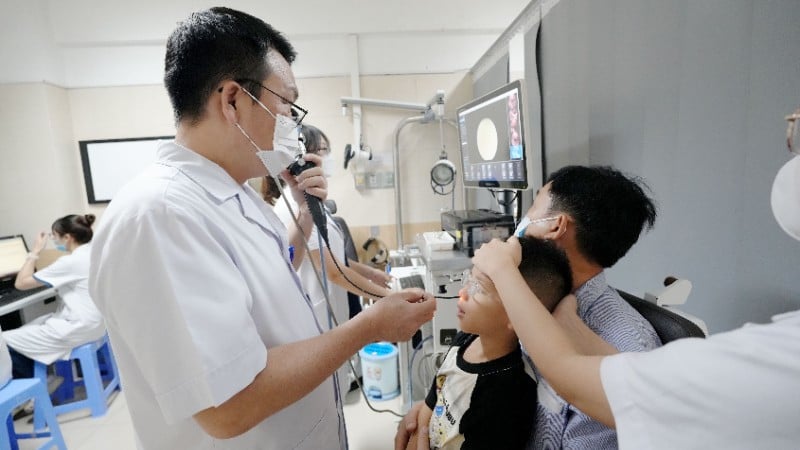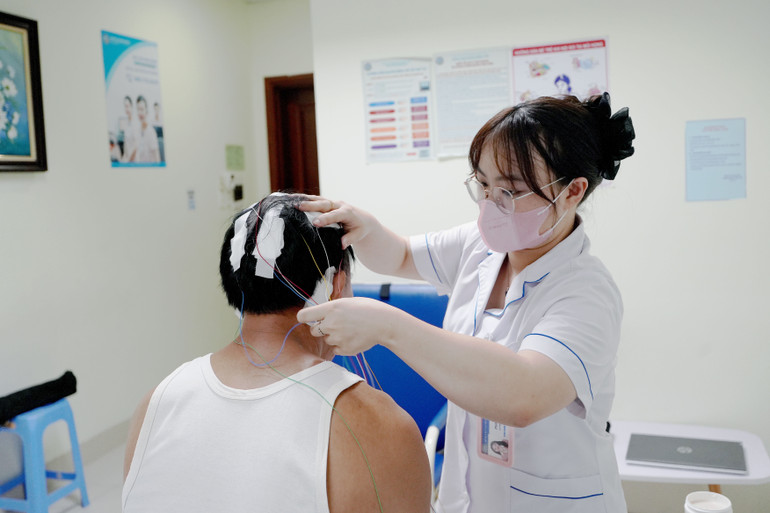
Snoring is a condition in which the flow of air through a narrowed airway creates a noisy sound while sleeping, this is a very common problem in life. Snoring can be physiological but can also be an early sign of a more serious disorder called obstructive sleep apnea syndrome.
This is the most common condition in sleep-disordered breathing, occurring in both children and adults, more commonly in men than women, and increasing with age.
Mr. BXM (34 years old, Hanoi ) suffers from severe snoring and sleep apnea. This condition causes his wife and children to lose sleep. During the day, he feels lethargic, tired, and sleepy all the time. He only drives for about an hour before having to stop and take a nap. Every time he drinks a little beer or wine, he wakes up suddenly when sleeping at night.
After being examined using 3 methods, Dr. Dao Dinh Thi - Head of Endoscopy Department - Central Ear, Nose and Throat Hospital and his colleagues at the hospital identified some narrow points and the level of sleep apnea of the patient.
Doctor Thi said that after taking the patient for a polysomnography, it showed that the patient had reduced breathing, stopped breathing more than 51 times/hour, the lowest oxygen saturation was 40% but because of his good health, he overcame it. The results of the sleep endoscopy determined that the patient had narrowing in the soft palate and tonsils. The doctors decided to perform surgery to remove the soft palate and tonsils and reduce the nasal turbinates because the patient had allergic rhinitis and was often stuffy.
After surgical treatment to widen the narrowed areas in the airway, patient M. had a polysomnography test that showed that the level of sleep apnea was only 9 times/hour and the blood oxygen saturation was over 90% during the entire sleep period.
According to Dr. Dao Dinh Thi, snoring and sleep apnea are two forms of the same disease. Snoring indicates that the airway has narrowed and it signals a larger syndrome, sleep apnea.
Dr. Dao Dinh Thi also emphasized that accurate diagnosis is considered an important factor for effective treatment.
Diagnosis is made through 3 stages of endoscopic examination to determine the stenosis while awake, in addition to determining the stenosis while sleeping we perform sleep endoscopy.
Doctors will put the patient into physiological sleep with medication. When the patient snores, the doctor will perform an endoscopy to know exactly where the narrowing point is to come up with an intervention plan.
In addition, for people with sleep apnea, polysomnography is also performed to determine the level of apnea. Polysomnography is an in-depth sleep test, including channels to measure electroencephalogram, eyeball, electromyogram, electrocardiogram, nasal and oral airflow, chest and abdominal muscle movement, blood oxygen saturation, snoring, body position, leg movement measurement, and video to monitor events during the night.
Therefore, polysomnography provides complete information about sleep as well as other disorders that occur during sleep such as respiratory disorders, sleep apnea, heart rhythm disorders, movement and behavioral abnormalities, etc.

The hospital now has full facilities that meet international standards for sleep endoscopy and polysomnography for patients. After receiving maximum support from diagnostic methods, the treatment process will be carried out depending on the condition of each patient.
According to clinical practice, the treatment success rate is over 95% in cases of snoring and sleep apnea. In only 5% of cases, the narrowing is too severe and cannot be treated surgically. The patient will have to use a continuous positive airway pressure (CPAP) device while sleeping.
Dr. Thi emphasized that if sleep apnea is not diagnosed and treated promptly, it can lead to serious complications such as myocardial infarction, diabetes, high blood pressure, arrhythmia, stroke... Therefore, recognizing the disease and treating it properly helps reduce the risk of dangerous complications.
Source: https://nhandan.vn/nguy-co-ngung-tho-khi-ngu-tu-tinh-trang-ngu-ngay-keo-dai-post898083.html


































































































Comment (0)